
Eric Gill works at the Midland Hotel, Morecambe include a sculpture, reliefs and a medallion.

Eric Gill works at the Midland Hotel, Morecambe include a sculpture, reliefs and a medallion.

The Art Deco Midland Hotel [1] was built in 1932–33 by the London Midland & Scottish Railway to the design of Oliver Hill [2] and included works by Gill, Marion Dorn, and Eric Ravilious. Eric Gill produced several works for the hotel. These were two seahorses, modelled as Morecambe shrimps, for the outside entrance, a round plaster relief on the ceiling of the circular staircase inside the hotel, a decorative wall map of the north west of England, and a large stone relief of Odysseus being welcomed from the sea by Nausicaa. [3]
The hotel had gradually become run down and neglected and eventually closed its doors to the public in 1993, but early in 2003 it was purchased by Urban Splash, a Manchester-based property company. Rebuilding work began in June 2005 and was completed three years later. [3]
The seahorses were carved in situ from Portland stone by Gill and his assistant, Donald Potter. When the hotel was renovated, it was found that the seahorses had been painted red and that they were much affected from exposure to the salty air. They were cleaned and repaired by craftsmen from Burnaby Stone Care Ltd. [3]

Designed and carved by Eric Gill and painted by Denis Tegetmeier (Gill’s son-in-law, who was a book illustrator). The medallion is on the ceiling at the top of the circular staircase in the hotel’s central tower. It is coloured in blue, blue green, yellow, and shades of red brown, and has the inscription "and hear old Triton blow his wreathed horn," words from a sonnet by William Wordsworth. [Note 1] The medallion is 10 feet (3.05 m) in diameter. Neptune sits wearing a crown and Triton emerges from the sea, clasping his golden horn in his hands. Two mermaids complete the ensemble. During the hotel’s renovation, the medallion was repaired and the colours restored by Brian Cardy of Urban Splash. Gill had added the marks of stigmata on Neptune. This is thought to have come about due to the death of his father, whom he also tried to depict in the face of Triton. [3]

Positioned in the entrance lounge, and behind the reception desk, this 10 ft 5 in (3.175 m) × 16 ft (4.877 m) bas-relief was carved in situ from Portland stone by Eric Gill with Laurie Cribb carrying out the lettering.
The bas-relief has the inscription "There is good hope that thou mayest see thy friends", and "Homer/Ody" in smaller capitals. This is repeated in Greek with "Eric G" added. Odysseus is shown being welcomed from the sea by Nausicaa, who is attended by three female servants. One carries a bowl of fruit, the second a jug and goblet and the third a garment. The panel is based on three episodes of a story in Homer’s Odyssey . [3]
Again carved and designed by Eric Gill and painted by Denis Tegetmeier in oil paint on a polished, natural ivory coloured "Marplax" surface on a plaster ground and measuring 8 ft 6 in (2.59 m) x 17 ft 2 in (5.23 m). Completed in 1933, the map shows the northwest coastline from Whitehaven in the north to Birkenhead in the south, with many places being indicated by a feature associated with them. The London Midland & Scottish connection sees mention of the Midland Hotel itself, the Adelphi Hotel in Liverpool and the Royal Scot train. Among other features represented are Blackpool Tower, Furness Abbey, Lancaster Castle, the factory chimneys of Liverpool and Preston, Liverpool's two cathedrals, and the shipyard cranes of Barrow-in-Furness, as well as the coal mines of Whitehaven. The Liverpool Metropolitan Cathedral depicted was based on Edwin Lutyens' proposed building which was never finished: the present Roman Catholic cathedral stands where Lutyens' building would have stood. The Lake District is shown for the most part as an idyllic part of the region with, for example, hounds chasing a fox near Haweswater and leafy trees, blue lakes and rounded fells. [3]
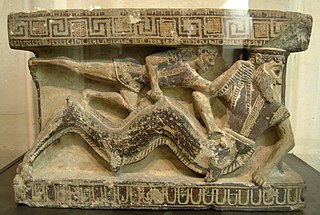
Triton is a Greek god of the sea, the son of Poseidon and Amphitrite, god and goddess of the sea respectively. Triton lived with his parents in a golden palace on the bottom of the sea. Later he was often depicted as having a conch shell he would blow like a trumpet.

Arthur Eric Rowton Gill was an English sculptor, letter cutter, typeface designer, and printmaker. Although the Oxford Dictionary of National Biography describes Gill as ″the greatest artist-craftsman of the twentieth century: a letter-cutter and type designer of genius″, following revelations of his sexual abuse of two of his daughters, he remains a figure of considerable controversy.

Sir Edwin Landseer Lutyens was an English architect known for imaginatively adapting traditional architectural styles to the requirements of his era. He designed many English country houses, war memorials and public buildings. In his biography, the writer Christopher Hussey wrote, "In his lifetime (Lutyens) was widely held to be our greatest architect since Wren if not, as many maintained, his superior". The architectural historian Gavin Stamp described him as "surely the greatest British architect of the twentieth century".

Liverpool Metropolitan Cathedral, officially known as the Metropolitan Cathedral of Christ the King and locally nicknamed "Paddy's Wigwam", is the seat of the Archbishop of Liverpool and the mother church of the Roman Catholic Archdiocese of Liverpool in Liverpool, England. The Grade II* Metropolitan Cathedral is one of Liverpool's many listed buildings.
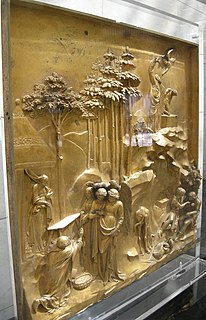
The term relief refers to a sculptural method in which the sculpted pieces are bonded to a solid background of the same material. The term relief is from the Latin verb relevo, to raise. To create a sculpture in relief is to give the impression that the sculpted material has been raised above the background plane. When a relief is carved into a flat surface of stone or wood, the field is actually lowered, leaving the unsculpted areas seeming higher. The approach necessitates a lot of chiselling away of the background, which takes a long time. On the other hand, a relief saves forming the rear of a subject, and is less fragile and more securely fixed than a sculpture in the round, especially one of a standing figure where the ankles are a potential weak point, especially in stone. In other materials such as metal, clay, plaster stucco, ceramics or papier-mâché the form can be just added to or raised up from the background, and monumental bronze reliefs are made by casting.

St George's Hall is a building on St George's Place, opposite Lime Street railway station in the centre of Liverpool, England. Opened in 1854, it is a Neoclassical building which contains concert halls and law courts, and is recorded in the National Heritage List for England as a designated Grade I listed building. On the east side of the hall, between it and the railway station, is St George's Plateau and on the west side are St John's Gardens. The hall is included in the William Brown Street conservation area.
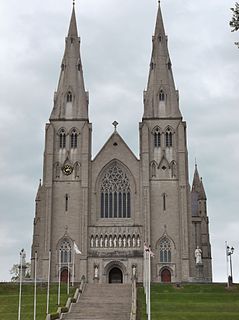
St. Patrick's Cathedral in Armagh, Northern Ireland is the seat of the Catholic Archbishop of Armagh, Primate of All Ireland. It was built in various phases between 1840 and 1904 to serve as the Roman Catholic Cathedral of the Archdiocese of Armagh, the original Medieval Cathedral of St. Patrick having been appropriated by the state church called the Church of Ireland at the time of the Irish Reformation.
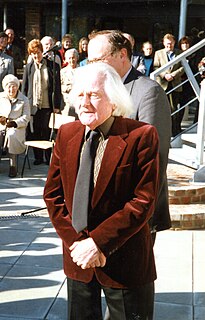
Donald Steele Potter was an English sculptor, wood carver, potter and teacher.

Wood carving is one of the oldest arts of humankind. Wooden spears from the Middle Paleolithic, such as the Clacton Spear, reveal how humans have engaged in utilitarian woodwork for millennia. Indeed, the beginnings of the craft go so far back that, at least where timber is present, the use of wood exists as a universal in human culture as both a means to create or enhance technology and as a medium for artistry. But in most parts of the world wood decays quickly and there are only isolated survivals from ancient times. The North American Indian carves his wooden fish-hook or his pipe stem just as the Polynesian works patterns on his paddle. The native of Guyana decorates his cassava grater with a well-conceived scheme of incised scrolls, while the native of Loango Bay distorts his spoon with a design of figures standing up in full relief carrying a hammock. Wood carving is also present in architecture.

The Midland Hotel is a Streamline Moderne building in Morecambe, Lancashire, England. It was built by the London, Midland and Scottish Railway (LMS), in 1933, to the designs of architect Oliver Hill, with sculpture by Eric Gill, and murals by Eric Ravilious. It is a Grade II* listed building. The hotel has been restored by Urban Splash with architects Union North, Northwest Regional Development Agency and Lancaster City Council.

Aubrey Eric Stacy Aumonier, was a British sculptor.

Morecambe is a seaside town in the City of Lancaster district in Lancashire, England, on the southern coast of Morecambe Bay.

Didsbury railway station is a former station in Didsbury, in the southern suburbs of Manchester, England, United Kingdom. The station was located on Wilmslow Road, just north of the junction with Barlow Moor Road and opposite Didsbury Library. Nothing now remains of the old station buildings, which have been demolished, but the surviving white Portland stone clock tower is a local landmark. Didsbury is now served by Didsbury Village tram stop which is close to the site of the former railway station.
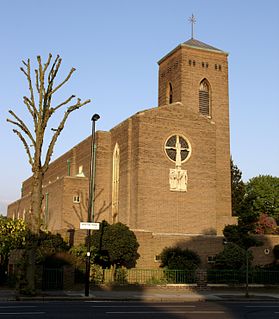
St Thomas the Apostle is a Church of England church, which is situated along Boston Road in Hanwell, in the London Borough of Ealing. Designed by Sir Edward Maufe, It forms part of the Diocese of London and can hold 428 people. English Heritage has listed it as a Grade II* building.

Manchester Cenotaph is a war memorial in St Peter's Square, Manchester, England. Manchester was late in commissioning a First World War memorial compared with most British towns and cities; the city council did not convene a war memorial committee until 1922. The committee quickly achieved its target of raising £10,000 but finding a suitable location for the monument proved controversial. The preferred site in Albert Square would have required the removal and relocation of other statues and monuments, and was opposed by the city's artistic bodies. The next choice was Piccadilly Gardens, an area already identified for a possible art gallery and library; but in the interests of speedier delivery, the memorial committee settled on St Peter's Square. The area within the square had been had been purchased by the City Council in 1906, having been the site of the former St Peter's Church; whose sealed burial crypts remained with burials untouched and marked above ground by a memorial stone cross. Negotiations to remove these stalled so the construction of the cenotaph proceeded with the cross and burials in situ.

Rochdale Cenotaph is a First World War memorial on the Esplanade in Rochdale, Greater Manchester, in the north west of England. Designed by Sir Edwin Lutyens, it is one of seven memorials in England based on his Cenotaph in London and one of his more ambitious designs. The memorial was unveiled in 1922 and consists of a raised platform bearing Lutyens' characteristic Stone of Remembrance next to a 10-metre (33 ft) pylon topped by an effigy of a recumbent soldier. A set of painted stone flags surrounds the pylon.
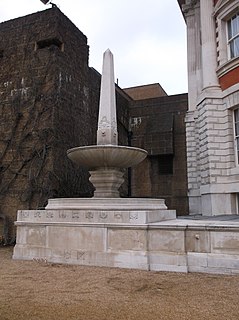
The Royal Naval Division Memorial is a First World War memorial located on Horse Guards Parade in central London, and dedicated to members of the 63rd Division (RND) killed in that conflict. Sir Edwin Lutyens designed the memorial, which was unveiled on 25 April 1925—ten years to the day after the Gallipoli landings, in which the division suffered heavy casualties. Shortly after the war, former members of the division established a committee, chaired by one of their leading officers, Brigadier-General Arthur Asquith, to raise funds for a memorial. Progress was initially slow. The committee planned to incorporate its memorial into a larger monument proposed by the Royal Navy for Trafalgar Square. When the navy abandoned that project, the RND's committee decided to proceed independently. They engaged Lutyens, who, after negotiation with the Office of Works, produced a design for a fountain connected to the balustrade of the Admiralty Extension building.
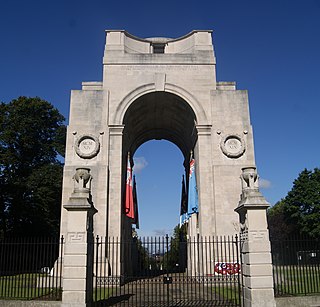
The Arch of Remembrance is a First World War memorial designed by Sir Edwin Lutyens and located in Victoria Park, Leicester, in the East Midlands of England. Leicester's industry contributed significantly to the British war effort. A temporary war memorial was erected in 1917, and a committee was formed in 1919 to propose a permanent memorial. The committee resolved to appoint Lutyens as architect and to site the memorial in Victoria Park. Lutyens's first proposal was accepted by the committee but was scaled back and eventually cancelled due to a shortage of funds. The committee then asked Lutyens to design a memorial arch, which he presented to a public meeting in 1923.
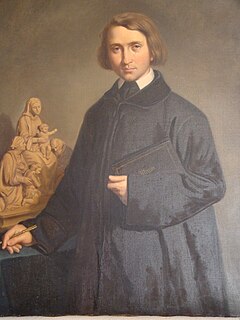
Jean-Marie Valentin, was born at Bourg-des-Comptes in Ille-et-Vilaine on 17 October 1823 and died in Paris on 8 August 1896. He was an architect and a sculptor specialising in religious furnishings such as pulpits, altars and statues. His father Antoine Louis Valentin was a master carpenter working mostly in ebony. He was born in 1784. Jean-Marie first worked at his father's workshop.

Bristol Cenotaph is a war memorial at the north end of Magpie Park, in Bristol, erected in 1932. It is a Grade II listed building.